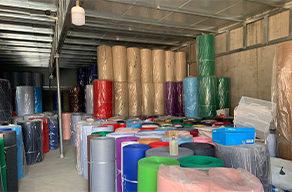Exploring the Versatility and Applications of Non-Woven Polyester Felt in Various Industries
Understanding Non-Woven Polyester Felt An Overview
Non-woven polyester felt is a versatile material that has gained significant attention across various industries due to its unique properties and applications. This synthetic textile, made from polyester fibers, is produced through a process that involves bonding fibers together mechanically, thermally, or chemically, eliminating the need for traditional weaving or knitting methods. This article delves into the characteristics, advantages, manufacturing processes, and diverse applications of non-woven polyester felt.
Characteristics of Non-Woven Polyester Felt
One of the standout features of non-woven polyester felt is its durability. The material exhibits excellent strength and resilience, allowing it to withstand wear and tear, making it ideal for both industrial and household applications. Additionally, non-woven polyester felt is lightweight, which adds to its versatility. The felt is also resistant to water, chemicals, and UV light, enhancing its longevity and making it suitable for outdoor applications.
Another important characteristic is its acoustic properties. Non-woven polyester felt has sound-dampening qualities, which make it effective in reducing noise levels in various environments. This feature is particularly beneficial in commercial spaces such as offices, restaurants, and auditoriums, where control over sound and acoustics is crucial.
Manufacturing Process
The manufacturing of non-woven polyester felt involves several key steps. The first step is fiber production, where polyester is spun into fine fibers. The next step is opening and blending these fibers to ensure uniformity. Following that, the fibers are laid out in a web-like structure using a mechanized process. Depending on the desired thickness and density, various techniques such as needle punching, thermal bonding, or chemical bonding are employed to bond these fibers together.
non woven polyester felt

The bounded structure is then subjected to finishing processes, including dyeing, coating, or laminating, which can enhance the material's properties or prepare it for specific applications. The final product can vary in thickness, texture, and color, catering to the diverse needs of consumers and industries.
Applications of Non-Woven Polyester Felt
The applications of non-woven polyester felt are extensive and span multiple industries. In the automotive sector, it is used for sound insulation, carpets, and interior linings, helping to enhance comfort and reduce road noise. In the construction industry, its durability makes it an excellent choice for roofing materials, insulation, and barriers against moisture.
In the realm of home and fashion, non-woven polyester felt is finding its way into a variety of products including crafting materials, bags, and home decor items. Its ease of manipulation, vibrant colors, and ability to hold shapes make it a favorite among designers and crafters. Additionally, in the medical field, non-woven polyester felt is used in disposable products, surgical drapes, and wound dressings due to its hygienic properties.
Moreover, the eco-friendliness of non-woven polyester felt cannot be overlooked. It is often produced from recycled materials, contributing to sustainability efforts in material production. The recycling process not only helps in reducing waste but also lowers the carbon footprint associated with manufacturing.
Conclusion
In summary, non-woven polyester felt is a robust and adaptable material that finds usage across a myriad of sectors. Its unique properties, such as durability, water resistance, and acoustic control, make it an asset in industries as varied as automotive, construction, fashion, and healthcare. As the demand for sustainable materials continues to rise, the non-woven polyester felt is likely to play a critical role in meeting that demand, providing reliable solutions while also considering environmental impacts. Understanding its characteristics and applications can empower businesses and consumers to make informed choices regarding the materials they use, further driving innovation and sustainability in various fields.
-
Your Go-To Guide For Affordable Wholesale Wool FeltNewsOct.31,2024
-
The Trusted Source For Industrial Felt And Hotel TowelsNewsOct.31,2024
-
Premium Industrial Felt Solutions For Every IndustryNewsOct.31,2024
-
Enhancing Performance With Industrial Felt FabricsNewsOct.31,2024
-
Elevating Performance With High-Quality Industrial Felt MaterialsNewsOct.31,2024
-
Brighten Your Projects With Vibrant Colored FeltNewsOct.31,2024
-
Unleash Your Creativity with Stylish Felt ProductsNewsOct.30,2024







